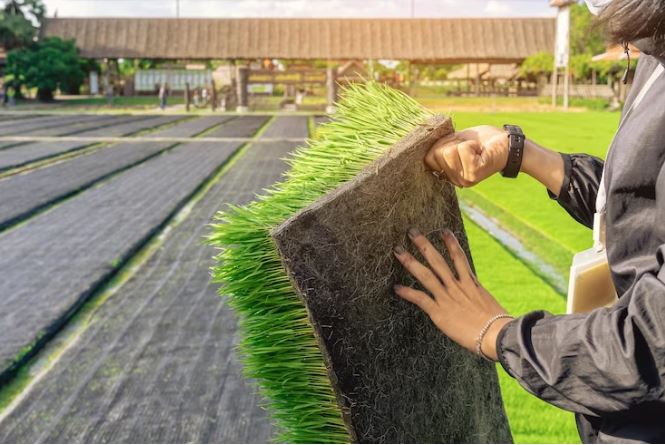Providing Discount Landscape
When to Prefer Synthetic Turf over Natural Grass?

Choosing between synthetic turf and natural grass for landscaping or sports fields can be a tough decision. While each option has benefits and drawbacks, synthetic turf might be the better option in some circumstances. This blog will discuss the things to think about when choosing synthetic turf over real grass and the situations in which it might be more advantageous.
Advantages of Synthetic Turf
Low Maintenance: Synthetic turf requires minimal maintenance compared to natural grass. With synthetic turf, there’s no need for mowing, watering, fertilizing, or pesticides, saving both time and money on upkeep. This makes synthetic turf the perfect option for locations—like commercial buildings, urban settings, or heavily trafficked sports facilities—where routine maintenance is either impractical or prohibitively expensive.
Durability: Synthetic turf is highly durable and can withstand heavy foot traffic, extreme weather conditions, and constant use without showing signs of wear and tear. Unlike natural grass, which can become worn, patchy, or muddy in high-traffic areas, synthetic turf maintains its lush appearance and playability year-round. Because of this, synthetic turf is a great choice for playgrounds, sports fields, and outdoor spaces where longevity is a must.
Water Conservation: Synthetic turf is an environmentally friendly option that helps conserve water by eliminating the need for irrigation. In regions prone to drought or water restrictions, synthetic turf can provide a green and visually appealing landscape without the need for regular watering. Synthetic turf aids in water conservation and the preservation of natural resources by using less water.
Versatility: Synthetic turf offers versatility in design and application, allowing for creative landscaping solutions in a variety of settings. Synthetic turf can be installed on flat or sloped surfaces, in shaded or sunny areas, and even indoors. It is appropriate for rooftop gardens, business landscapes, residential lawns, and more since it can be tailored to match any area or style.
When to Prefer Synthetic Turf
High-Traffic Areas: Synthetic turf is an excellent choice for high-traffic areas where natural grass may struggle to thrive. High foot traffic can harm natural grass and present safety risks in sports fields, playgrounds, pet parks, and recreational areas. Synthetic turf provides a durable and resilient surface that can withstand constant use without sacrificing performance or aesthetics.
Low-Maintenance Landscaping: If you’re looking for a low-maintenance landscaping solution that requires minimal upkeep, synthetic turf may be the way to go. Synthetic turf eliminates the need for mowing, watering, fertilizing, and pesticides, saving time, money, and resources on maintenance. This makes synthetic turf a practical choice for busy homeowners, commercial properties, and public spaces looking to maintain a green and inviting landscape with minimal effort.
Water-Scarce Regions: In regions facing water scarcity or drought conditions, synthetic turf offers a water-efficient alternative to natural grass. Synthetic turf requires no irrigation, reducing water consumption and helping conserve valuable resources. By opting for synthetic turf, homeowners, businesses, and municipalities can maintain attractive landscapes without contributing to water shortages or environmental degradation.
Allergy Concerns: For individuals with allergies to pollen or grasses, synthetic turf provides a hypoallergenic alternative to natural grass. Synthetic turf eliminates pollen, weeds, and other allergens that can trigger allergic reactions, providing a safe and comfortable outdoor environment for allergy sufferers. This makes synthetic turf an ideal choice for residential yards, parks, and public spaces where allergies may be a concern.
Conclusion
While natural grass has its charm and benefits, synthetic turf offers distinct advantages in terms of low maintenance, durability, water conservation, and versatility. By considering factors such as high-traffic areas, low-maintenance landscaping, water scarcity, and allergy concerns, you can determine whether synthetic turf is the preferred choice for your landscaping or sports field needs. Whether you’re looking to create a vibrant lawn, a durable sports field, or a water-efficient landscape, synthetic turf offers a practical and sustainable solution that delivers long-lasting performance and aesthetics.
